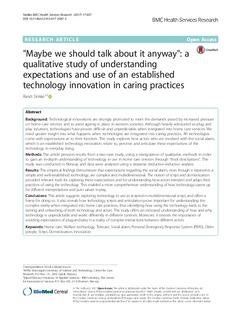| dc.contributor.author | Stokke, Randi | |
| dc.date.accessioned | 2017-10-05T07:47:28Z | |
| dc.date.available | 2017-10-05T07:47:28Z | |
| dc.date.created | 2017-09-18T08:47:38Z | |
| dc.date.issued | 2017 | |
| dc.identifier.citation | BMC Health Services Research. 2017, 17 . | nb_NO |
| dc.identifier.issn | 1472-6963 | |
| dc.identifier.uri | http://hdl.handle.net/11250/2458566 | |
| dc.description.abstract | Background
Technological innovations are strongly promoted to meet the demands posed by increased pressure on home care services and to assist ageing in place in western societies. Although heavily advocated as plug and play solutions, technologies have proven difficult and unpredictable when integrated into home care services. We need greater insight into what happens when technologies are integrated into caring practices. All technologies come with expectations as to their function. This study explores how actors who are involved with the social alarm, which is an established technology innovation, relate to, perceive and articulate these expectations of the technology in everyday living.
Methods
The article presents results from a two-case study, using a triangulation of qualitative methods in order to gain an in-depth understanding of technology in use in home care services through “thick descriptions”. The study was conducted in Norway and data were analysed using a stepwise deductive-inductive analysis.
Results
The empirical findings demonstrate that expectations regarding the social alarm, even though it represents a simple and well-established technology, are complex and multidimensional. The notion of script and domestication provided relevant tools for exploring these expectations and for understanding how actors interpret and adapt their practices of using the technology. This enabled a more comprehensive understanding of how technology opens up for different interpretations and puts values in play.
Conclusions
This article suggests exploring technology in use as scripted in multidimensional script, and offers a frame for doing so. It also reveals how technology scripts and articulation prove important for understanding the complex reality when integrated into home care practices, thus identifying how using the technology leads to the taming and unleashing of both technology and actors. The study offers an increased understanding of how and why technology is unpredictable and works differently in different contexts. Moreover, it stresses the importance of avoiding expectations of plug-and-play in a reality of complex interactions between different actors. | nb_NO |
| dc.language.iso | eng | nb_NO |
| dc.publisher | BioMed Central | nb_NO |
| dc.rights | Navngivelse 4.0 Internasjonal | * |
| dc.rights.uri | http://creativecommons.org/licenses/by/4.0/deed.no | * |
| dc.title | "Maybe we should talk about it anyway": a qualitative study of understanding expectations and use of an established technology innovation in caring practices | nb_NO |
| dc.type | Journal article | nb_NO |
| dc.type | Peer reviewed | nb_NO |
| dc.description.version | publishedVersion | nb_NO |
| dc.source.pagenumber | 13 | nb_NO |
| dc.source.volume | 17 | nb_NO |
| dc.source.journal | BMC Health Services Research | nb_NO |
| dc.identifier.doi | 10.1186/s12913-017-2587-3 | |
| dc.identifier.cristin | 1494594 | |
| dc.description.localcode | © The Author(s). 2017. This article is distributed under the terms of the Creative Commons Attribution 4.0 International License (http://creativecommons.org/licenses/by/4.0/), which permits unrestricted use, distribution, and reproduction in any medium, provided you give appropriate credit to the original author(s) and the source, provide a link to the Creative Commons license, and indicate if changes were made. The Creative Commons Public Domain Dedication waiver (http://creativecommons.org/publicdomain/zero/1.0/) applies to the data made available in this article, unless otherwise stated. | nb_NO |
| cristin.unitcode | 194,18,23,50 | |
| cristin.unitname | Senter for omsorgsforskning | |
| cristin.ispublished | true | |
| cristin.fulltext | original | |
| cristin.qualitycode | 2 | |

